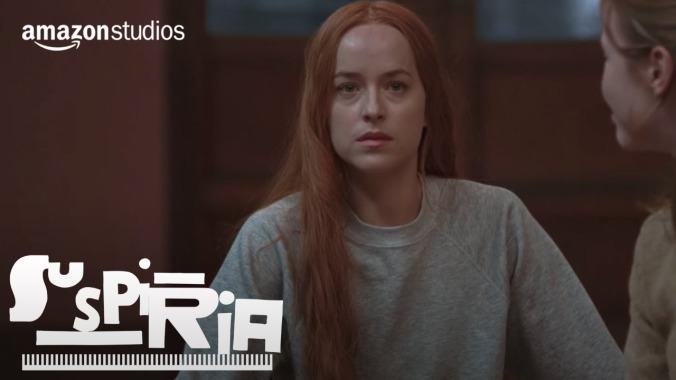Here's everything we know so far about Luca Guadagnino's Suspiria remake

Yeah, we know, hype can be lethal, especially when it comes to horror movies. But even though our reaction to the 2008 announcement that a sequel to Dario Argento’s Suspiria was in development was one of abject horror—or perhaps even because of that initial revulsion—we’re intrigued by what we’ve seen of the final product, directed by Call Me By Your Name’s Luca Guadagnino after David Gordon Green departed to reinterpret a different ‘70s horror classic.
Rather than try to emulate Argento’s technicolor fairy tale, Guadagnino takes a more somber approach that’s still reminiscent of the auteur-driven art-horror of the 1970s, just with a completely different set of references. It’s a smart move, one that frees all involved from the pressure of trying to live up to the original’s massively influential style. Dakota Johnson stars as American ballet student Suzy Bannion, whose arrival at a German ballet school run by the severe Madame Blanc (Tilda Swinton) stirs the sinister supernatural forces who secretly run the school. Here’s what we know thus far:
Guadagnino’s been obsessed with Suspiria since he was 11. As he tells Deadline, “I first saw the poster for Dario’s movie when I was 11 in 1982. I saw the film two years later.” (In the interim, he hand-drew his own posters for the film, writing “Suspiria by Luca Guadagnino” on top.) He adds, “It made an incredible impression on me … For all the violence of Dario’s movies they are also beautiful fairy tales. There is something alluring about it for a young person.”
This remake has been in the works for a long time. Our first Newswire on the subject dates from 2010, in which we refer to “Pineapple Express director David Gordon Green” announcing plans to remake the film “a couple years” before that. The film spent most of the last decade in development, popping up in stories in 2012 and again in 2015, when Green dropped out and Guadagnino, who had signed on as a producer when the project first came together in 2008, took over. The official cause of Green’s departure, as we reported at the time, was “conflicting visions” for the film.
It’s Amazon Studios’ first horror movie. And the studio is really going for it, with an aggressive social-media marketing campaign—the @Suspiria Twitter account is very active—and two atmospheric trailers that both resulted in serious buzz. This morning, the studio released the official poster for the film:
Production began in the fall of 2016, right after Guadagnino finished filming Call Me By Your Name. The majority of the production took place at an abandoned hotel in the Italian city of Varese that the crew transformed into the “Tanz Dance Academy,” an experience Johnson described in an interview with Elle. “We were in an abandoned hotel on top of a mountain. It had 30 telephone poles on the roof, so there was electricity pulsating through the building, and everyone was shocking each other,” she said. “It was cold as shit, and so dry.” Shooting also took place in Berlin, for a production that lasted three months and cost $20 million.
It’s set in Berlin in 1977, the year the original Suspiria was released in theaters. The original Suspiria takes place in the fairytale town of Freiburg in southeast Germany, but the remake moves the action to the oppressive concrete streets of 1977 Berlin, a city split in half by the Berlin Wall. Guadagnino reportedly incorporates the charged political atmosphere of the time, when the radical leftists in the Baader-Meinhof Group were in constant conflict with German authorities, into the film.
Its aesthetic was inspired by the Polish-French painter Balthus and the films of Rainer Werner Fassbinder. Balthus, who died in 2001, is known for his murky, dreamlike portraits of adolescent girls, painted in various states of undress. Exhibitions of his work have been controversial due to the fact that many of the models for these erotically charged paintings were underage, which gives his art a disturbing undertone. Fassbinder, meanwhile, was a prolific leader of the New German Cinema movement of the ‘70s who’s best remembered for tragic, humanist melodramas like Ali: Fear Eats The Soul and The Bitter Tears Of Petra Von Kant. “Fassbinder was this gigantic filmmaker of cruelty who goes so deep into character. I have always loved the cinema of extremes,” Guadagnino tells Variety. He also shouts out performance artist Joseph Beuys and radical feminist art in various interviews, so yeah, there’s a lot going on here—all of it ‘70s and avant-garde.
Original star Jessica Harper is in it. This was first announced back in 2016, when the film had just started production. She doesn’t feature prominently in either of the trailers released so far, but Harper does appear in a photo spread published in Vanity Fair Italia alongside Swinton, Johnson, Mia Goth, and Chloë Grace Moretz, suggesting her role is more than just a cameo. She added on Facebook that she thinks the remake is “the most brilliantly scary film I have ever seen.”








































